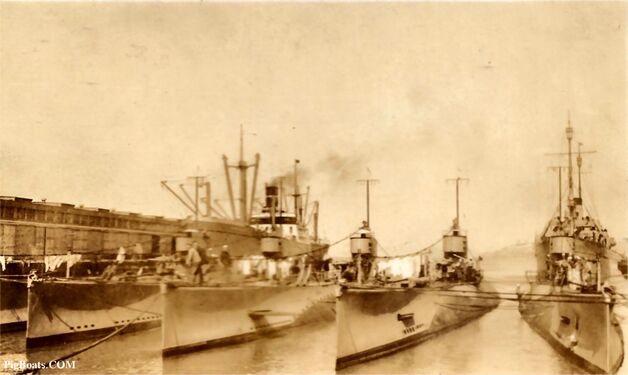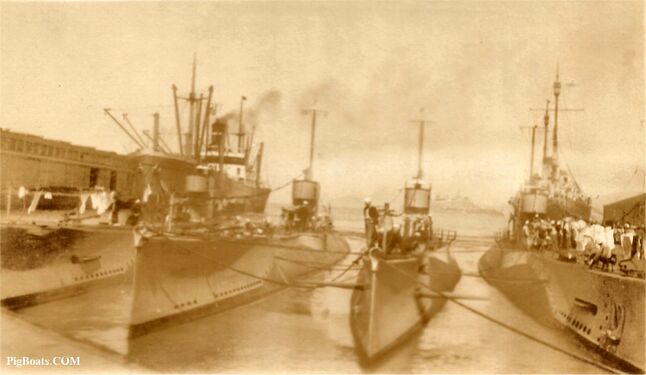S-class group photos: Difference between revisions
Pbcjohnston (talk | contribs) mNo edit summary |
Pbcjohnston (talk | contribs) |
||
| (3 intermediate revisions by the same user not shown) | |||
| Line 1: | Line 1: | ||
[[File:S- | [[File:New Header EB S-boats.jpg]] | ||
__TOC__ | |||
==Various External & Group Photos== | |||
[[File:Gov S-boat stern 1.jpg|left|500px]] | [[File:Gov S-boat stern 1.jpg|left|500px]] | ||
| Line 50: | Line 54: | ||
[[File:S-boat and dd selfridge.jpg|left|500px]] | [[File:S-boat and dd selfridge.jpg|left|500px]] | ||
<div style="text-align: justify;"><span style="color:#00008B">What exactly is going on in this photo is not known. It looks like some sort of boat race, even with two of the small boats having a lot of sailors in them. The date is likely the later 1920's and the location is unknown, but it looks like San Diego. An unknown 20 series S-boat is on the right. On the left is a large nest of destroyers, with the outboard ship being the USS Selfridge (DD-320). | <div style="text-align: justify;"><span style="color:#00008B">What exactly is going on in this photo is not known. It looks like some sort of boat race, even with two of the small boats having a lot of sailors in them. The date is likely the later 1920's and the location is unknown, but it looks like San Diego. An unknown 20 series S-boat is on the right. On the left is a large nest of destroyers, with the outboard ship being the USS Selfridge (DD-320). | ||
<small>Photo in the private collection of Ric Hedman.</small> | <small>Photo in the private collection of Ric Hedman.</small> | ||
| Line 185: | Line 161: | ||
[[File:Canopus and S-class and fleet boats.jpg|left|500px]] | [[File:Canopus and S-class and fleet boats.jpg|left|500px]] | ||
<div style="text-align: justify;"><span style="color:#00008B">Submarine Squadron 5 is shown here moored to its mother ship, the submarine tender USS Canopus (AS-9). The location is likely Manila Bay, Philippines off Cavite. The S-boats on the left make up Submarine Division 201 and on the left are the fleet submarines of Submarine Division 203. | <div style="text-align: justify;"><span style="color:#00008B">Submarine Squadron 5 is shown here moored to its mother ship, the submarine tender USS Canopus (AS-9). The location is likely Manila Bay, Philippines off Cavite. The S-boats on the left make up Submarine Division 201 and on the left are the fleet submarines of Submarine Division 203. | ||
<small>Photo in the private collection of Ric Hedman.</small> | |||
[[File:Red bar sub new.jpg]] | |||
<div style="text-align: justify;"><span style="color:#000000"> | |||
==Internal Photos== | |||
===Electric Boat (EB) Design=== | |||
[[File:S-boat torp room.jpg|left|500px]] | |||
<div style="text-align: justify;"><span style="color:#00008B">An unknown EB design S-boat torpedo room looking forward. A Mk 10 reload torpedo can be seen on either side of the photo. | |||
<small>Photo in the private collection of Ric Hedman.</small> | |||
[[File:Red bar sub new.jpg]] | |||
[[File:S-boat control room periscopes.jpg|left|500px]] | |||
<div style="text-align: justify;"><span style="color:#00008B">The interior of an unknown EB design S-boat. This is the control room looking forward and to port. The helm wheel is on the right, with the diving planes control wheels on the left and the depth gauges between them. A periscope is in the foreground in the middle, along with a large ventilation pipe. | |||
<small>Photo in the private collection of Ric Hedman.</small> | |||
[[File:Red bar sub new.jpg]] | |||
[[File:S-boat control room.jpg|left|500px]] | |||
<div style="text-align: justify;"><span style="color:#00008B">Another view of the same scene as above, looking aft in the control room of an unknown EB design S-boat. The large kettle-shaped object on the left is the gyroscope. The door leads to the after battery compartment. | |||
<small>Photo in the private collection of Ric Hedman.</small> | |||
[[File:Red bar sub new.jpg]] | |||
[[File:S-boat engine room.jpg|left|500px]] | |||
<div style="text-align: justify;"><span style="color:#00008B">This is an EB design S-boat engine room looking forward. The NELSECO 8-EB-15 engines are on either side. The door leads to the after battery compartment. | |||
<small>Photo in the private collection of Ric Hedman.</small> | |||
[[File:Red bar sub new.jpg]] | |||
<div style="text-align: justify;"><span style="color:#000000"> | |||
===Government (BuC&R) Design=== | |||
[[File:S-boat Govt design torpedo room.jpg|left|500px]] | |||
<div style="text-align: justify;"><span style="color:#00008B">The torpedo room of an unknown Government design S-boat, looking forward at the torpedo tube breech doors. Two Mk 9 or Mk 10 torpedoes can be seen on the left. There are two I-beam tracks in the overhead that are used to move weapons around the room. At the top center an electric chain winch can be seen. The profusion of valves are used to flood the tubes prior to firing, and to drain them after firing so that they can be reloaded. | |||
<small>Photo in the private collection of Ric Hedman.</small> | |||
[[File:Red bar sub new.jpg]] | |||
[[File:S-boat Govt design battery compartment.jpg|left|500px]] | |||
This view is of the battery compartment of an unknown Government design S-boat, looking forward. The Government design had only a single battery compartment, with the cells situated below the walking deck. Above the deck was the crew quarters, including officers, Chiefs, and junior enlisted. On the left and in the center behind the cabinet are fold down tubular frame bunks, and clothing lockers are on the right. The galley was actually in the control room, but the crew ate their meals in this space as well. | |||
<small>Photo in the private collection of Ric Hedman.</small> | |||
[[File:Red bar sub new.jpg]] | |||
[[File:S-class Govt design control room electrical.jpg|left|500px]] | |||
The control room of an unknown Government design S-boat. This view is looking aft and to starboard and shows the electrical distribution panel. The S-boats did not have a separate maneuvering room for this equipment, so all electrical distribution was controlled from here. Open knife switches and fuse panels presented a great hazard to the operator, and constant care had to be exercised to prevent an accidental electrocution. Even still, this was considered to be state of the art in the 1920s. | |||
<small>Photo in the private collection of Ric Hedman.</small> | |||
[[File:Red bar sub new.jpg]] | |||
[[File:S-class Govt design control room.jpg|left|500px]] | |||
Another view inside a Government design S-boat control room. This view is looking aft and to starboard. The ballast control manifold with its valves and gauges can be seen, along with one of three periscopes (raised, in foreground) and the 16" main air intake pipe behind the periscope. This photo was likely taken on one of the early boats in the early 1920s because the air intake pipe was eventually rerouted and eliminated from the control room. | |||
A gyrocompass repeater can be seen in the overhead to the left of the periscope. | |||
<small>Photo in the private collection of Ric Hedman.</small> | |||
[[File:Red bar sub new.jpg]] | |||
[[File:S-boat Govt design engine room.jpg|left|500px]] | |||
This is the engine room of an unknown Government design S-boat, looking aft and showing the port side NELSECO 8-EB-16 direct drive engine. The lack of suitable engines from other sources forced the Navy's Bureau of Construction & Repair and Bureau of Engineering to use an Electric Boat/NELSECO engine in the early Government design S-boats. | |||
Note the large valve rocker arms along the side of the engine. These constantly moving arms were a danger to the crew and the Motor Machinist Mates that operated the engines had to be very aware of them at all times. | |||
<small>Photo in the private collection of Ric Hedman.</small> | <small>Photo in the private collection of Ric Hedman.</small> | ||
Latest revision as of 16:26, 3 April 2025
Various External & Group Photos
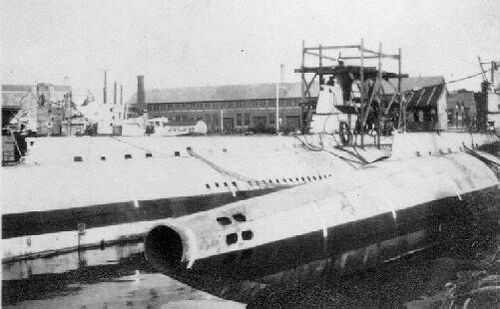
Photo in the private collection of Ric Hedman.
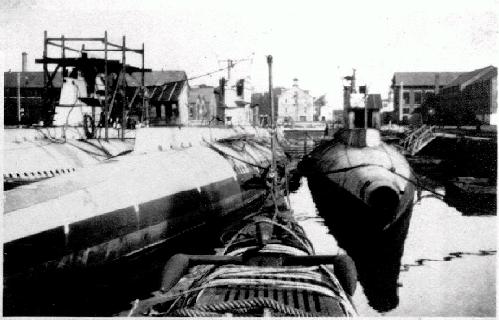
Photo in the private collection of Ric Hedman.
Photos in the private collection of Ric Hedman.
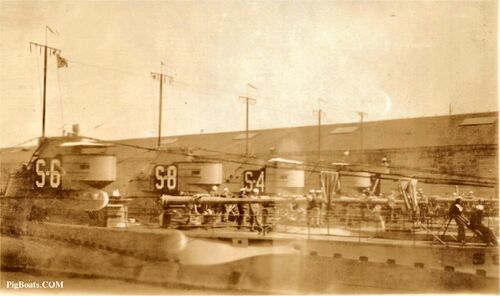
A different view of the boats from the two photos above. From left to right in this view are S-6, S-8, S-4, and S-7. The tall extendable radio masts are visible here. The very tall masts were needed to achieve long range communications with the relatively low-powered systems of the day.
Photo in the private collection of Ric Hedman.

Photo in the private collection of Ric Hedman.
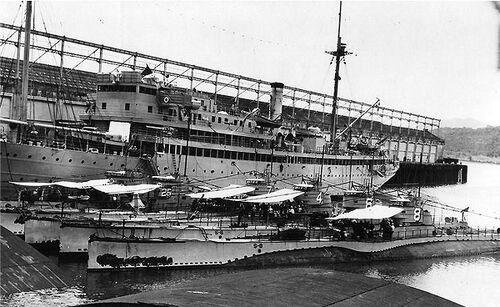
Photo in the private collection of Ric Hedman.
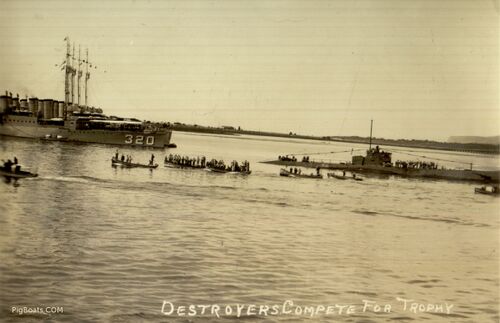
Photo in the private collection of Ric Hedman.
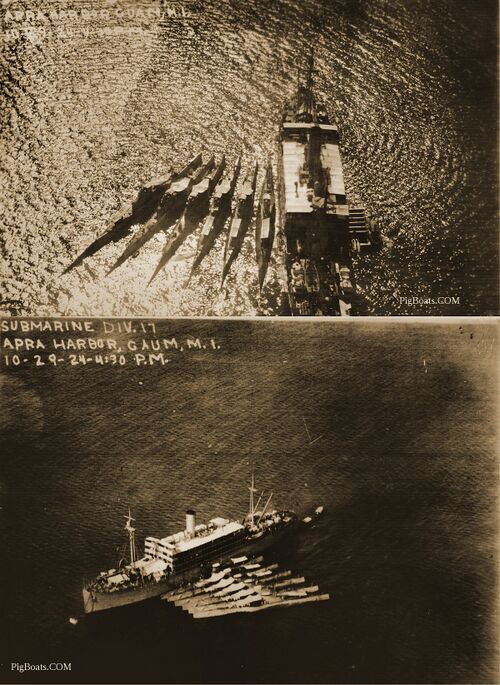
Photos in the private collection of Ric Hedman.

Photo in the private collection of Ric Hedman.

Photo in the private collection of Ric Hedman.
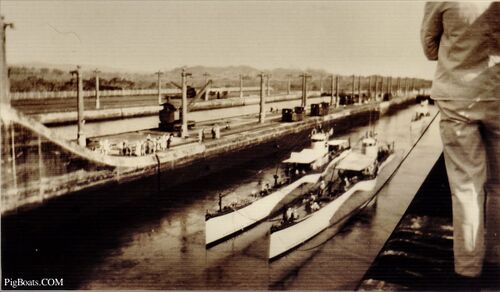
Three unidentified S-boats of the Government design in the locks at the Panama Canal, late 1920's. These boats are part of the S-10 group boats that had a stern torpedo tube and their bow planes below the water line. All four of those boats were regular visitors to the Canal Zone in the 1920's and early 1930's.
Photo in the private collection of Ric Hedman.
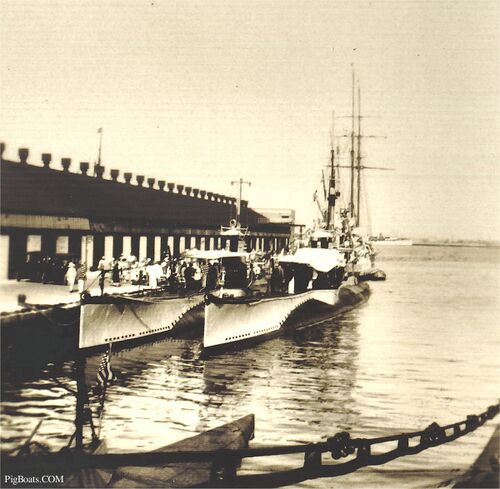
Two unidentified S-boats of the Government design, possibly S-8 or S-9 at an unknown location, late 1920's. These boats have the bow planes below the water line, ruling out the earlier Government design S-boats. There are two other Government design S-boats whose sterns can be seen at the bottom of the photo.
Photo in the private collection of Ric Hedman.
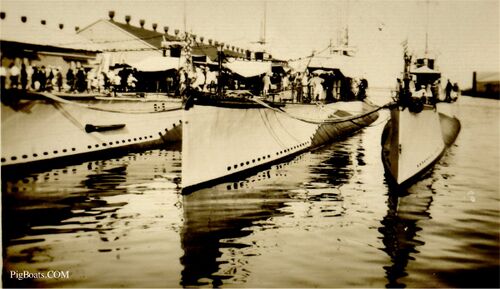
Three Government design S-boats sit alongside a pier in the mid 1920's. It was taken shortly after the photo above. The location is likely San Pedro (Los Angeles), California. S-15 (SS-120) is the inboard boat, with the other two unidentified, but they are one of the following: S-8 or S-9, or S-10 to S-13. Those six boats have the below water bow planes, and that feature of the Government design was only on those boats. This was an occasion that allowed civilian visitors, with a large number of guests on the pier.
Photo in the private collection of Ric Hedman.

Five S-boats moored together in an Asiatic port, approximately 1924-1929. The three boats in the middle are (left to right) S-2, S-36, and S-38. The two boats on the far left and the one on the far right are not identified, but they are 30 series S-boats. S-2 spent most of her service life in Asian waters, including several years in reserve status. She is shown here with her distinctive bow buoyancy tank hump and the horizontal slit for the retracted bow planes.
Photo in the private collection of Ric Hedman.

Four S-boats moored outboard of the tender USS Canopus (AS-9), approximately 1925. The location is believed to be Chefoo, China, a frequent port of call in those days. From inboard to outboard are S-36, S-38, S-39, and S-37.
Photo from the E.J. Hillin Collection, now in the private collection of Ric Hedman.

S-36 (SS-141) (foreground), S-41 (SS-146) (back right), and another unidentified EB design S-boat in the USS Dewey (YFD-1) floating drydock at Naval Station Subic Bay, Philippines in the 1930's. The Dewey was a fixture of the Asiatic Fleet, serving the Navy in fine fashion from 1905 to 1942, with its entire service being in Subic Bay. It was finally destroyed and sunk to prevent capture by the Japanese in 1942.
Photo in the private collection of Ric Hedman.
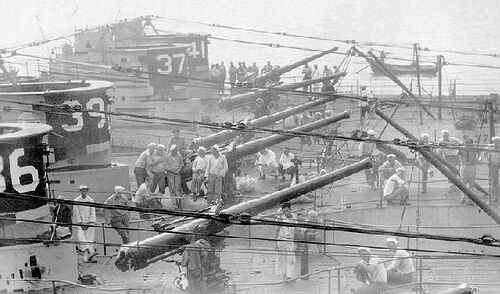
Photo courtesy of the NHHC.
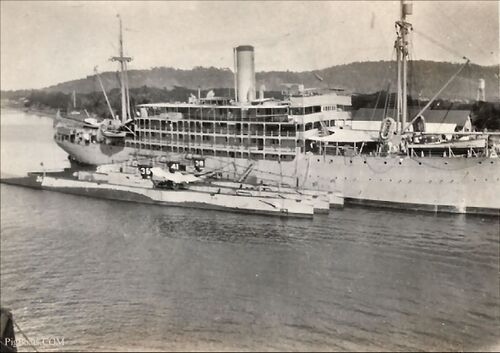
S-36, S-41, and S-38 alongside the tender USS Canopus (AS-9) at Naval Station Subic Bay, Philippines, approximately 1925 to 1931. Canopus became a staple of the Asiatic Fleet, serving her submarines well right up to 1942. She stoutly resisted all Japanese attempts to sink her, but bowing to the inevitability of the loss of the Philippines, her crew reluctantly scuttled her in Manila Bay on April 10, 1942 to prevent her capture. Rest easy good ship. You are not forgotten.
Photo in the private collection of Ric Hedman.
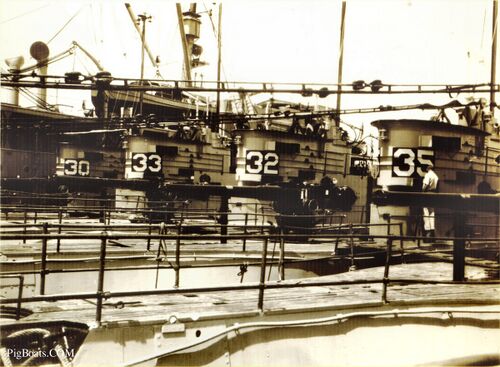
Photo in the private collection of Ric Hedman.
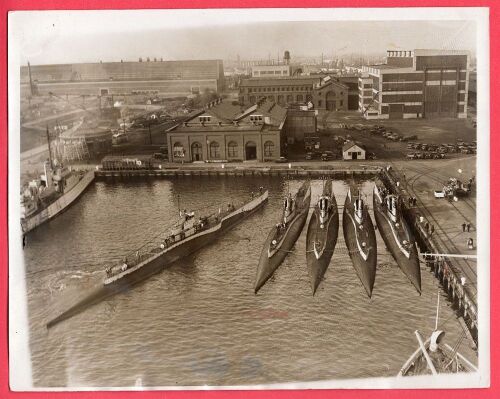
Photo courtesy of the Boston Public Library, Leslie Jones Collection. A printed copy is in the private collection of Ric Hedman.

Subic Bay became a mainstay of the U.S. Pacific Fleet in the post war years, even more so as naval activities at Cavite wound down in the 1950's. Subic became a major port of call and center of operations during the Vietnam War, and was bustling with activity during the Cold War in the 1980's. Webmaster Dave Johnston became very familiar with the place during that time. The pier in this photo was used for mooring large ships, even the USS New Jersey (BB-62) during a visit in 1985.
Photo in the private collection of Ric Hedman.

Photo in the private collection of Ric Hedman.
Internal Photos
Electric Boat (EB) Design

Photo in the private collection of Ric Hedman.

Photo in the private collection of Ric Hedman.
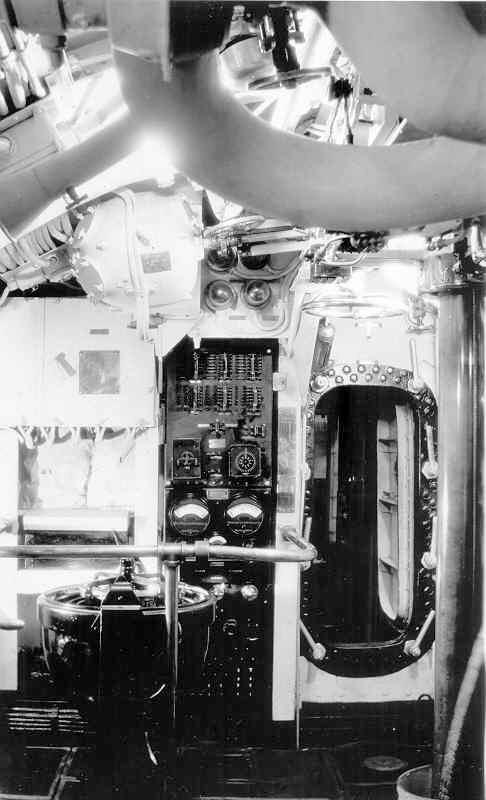
Photo in the private collection of Ric Hedman.
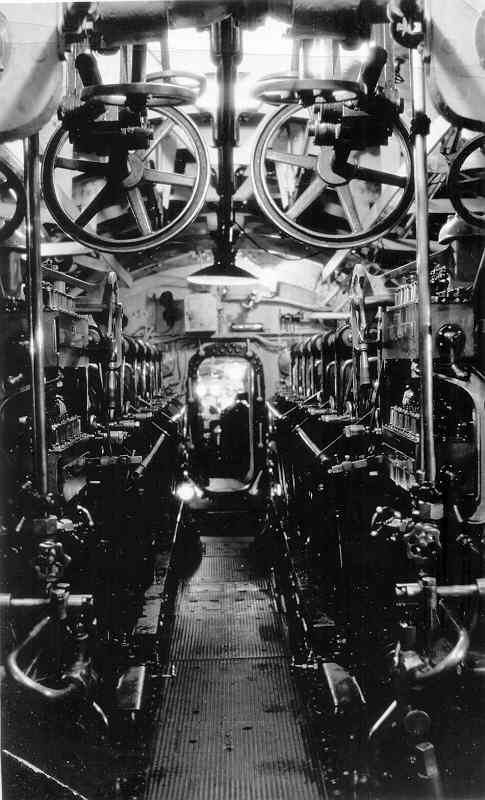
Photo in the private collection of Ric Hedman.
Government (BuC&R) Design

Photo in the private collection of Ric Hedman.
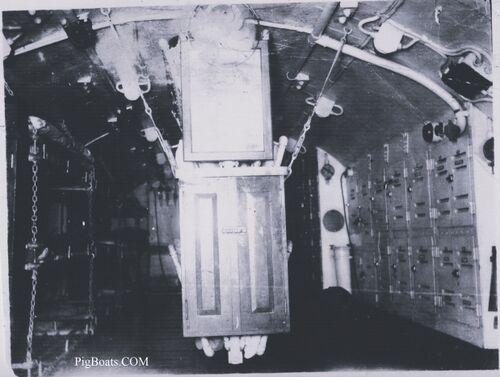
This view is of the battery compartment of an unknown Government design S-boat, looking forward. The Government design had only a single battery compartment, with the cells situated below the walking deck. Above the deck was the crew quarters, including officers, Chiefs, and junior enlisted. On the left and in the center behind the cabinet are fold down tubular frame bunks, and clothing lockers are on the right. The galley was actually in the control room, but the crew ate their meals in this space as well.
Photo in the private collection of Ric Hedman.

The control room of an unknown Government design S-boat. This view is looking aft and to starboard and shows the electrical distribution panel. The S-boats did not have a separate maneuvering room for this equipment, so all electrical distribution was controlled from here. Open knife switches and fuse panels presented a great hazard to the operator, and constant care had to be exercised to prevent an accidental electrocution. Even still, this was considered to be state of the art in the 1920s.
Photo in the private collection of Ric Hedman.
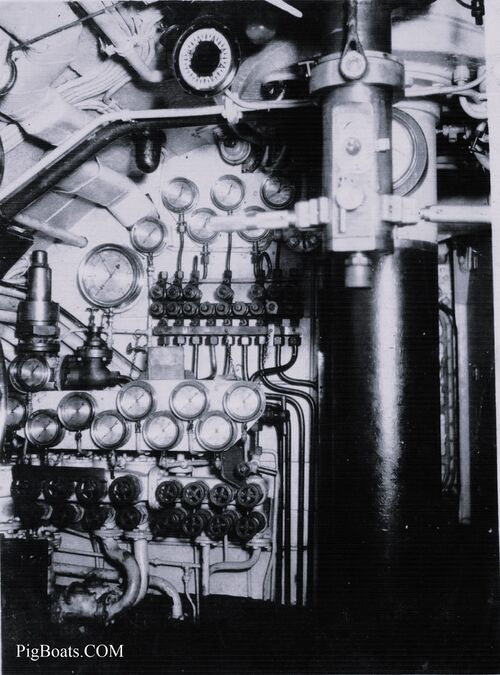
Another view inside a Government design S-boat control room. This view is looking aft and to starboard. The ballast control manifold with its valves and gauges can be seen, along with one of three periscopes (raised, in foreground) and the 16" main air intake pipe behind the periscope. This photo was likely taken on one of the early boats in the early 1920s because the air intake pipe was eventually rerouted and eliminated from the control room.
A gyrocompass repeater can be seen in the overhead to the left of the periscope.
Photo in the private collection of Ric Hedman.
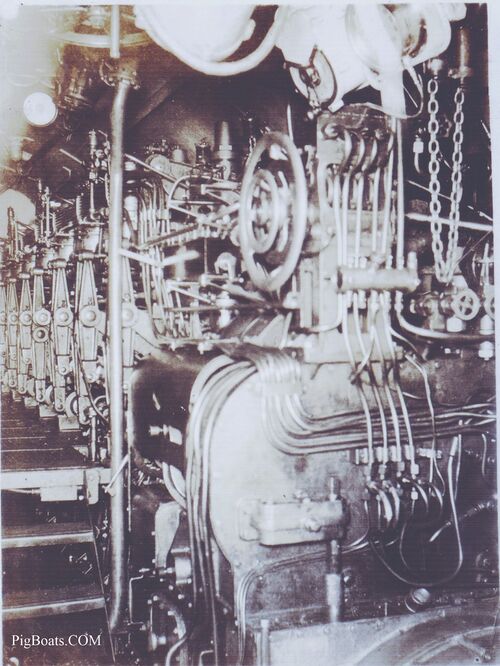
This is the engine room of an unknown Government design S-boat, looking aft and showing the port side NELSECO 8-EB-16 direct drive engine. The lack of suitable engines from other sources forced the Navy's Bureau of Construction & Repair and Bureau of Engineering to use an Electric Boat/NELSECO engine in the early Government design S-boats.
Note the large valve rocker arms along the side of the engine. These constantly moving arms were a danger to the crew and the Motor Machinist Mates that operated the engines had to be very aware of them at all times.
Photo in the private collection of Ric Hedman.
Page created by:
Ric Hedman & David Johnston
1999 - 2023 - PigBoats.COM©
Mountlake Terrace, WA, Norfolk, VA
webmaster at pigboats dot com

